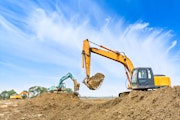Fleet Management for the Construction Industry 2024
Transform efficiency and productivity with fleet tracking technology...
Read more
Many were introduced to GPS years ago via portable dashboard devices that guided drivers with turn-by-turn directions. Today,technology has evolved to offer far more benefits than simple navigation.
In fact, GPS tracking is now an extremely valuable, multi-faceted business tool for the construction industry. It helps them track and manage their construction equipment, from towers and mobile cranes to earth moving equipment, service vehicles and heavy trucks.
Beyond that, GPS tracking is often used for all types of assets that are expensive or difficult to replace, such as generators and compressors, as a key component of heavy equipment management programs.
So, how exactly does an asset get tracked? Here are the basics:
Fleet managers have to oversee a large array of equipment and don’t have the time to weed through a high volume of status updates in order to find the actionable information they need.
For example, the Verizon Connect Fleet management solution can instantly parse the huge amount of data being generated from a few or thousands of tracked assets and give managers the specific insights they need. The solution has a one-screen dashboard that pinpoints all the assets on a map. From there, a manager can zoom in on a particular asset for more detail or review reports and alerts.
This is also where customers can see dashcam data from Verizon Connect’s Cloud AI (Video Analytics Engine) to gain additional context about exactly how the equipment is being used as its movements are tracked via GPS. In this way, managers can quickly obtain the insights needed to make informed decisions for deploying and safeguarding their drivers and vehicles.
Fleet managers can configure customised alerts to make sure their construction GPS systems provide the data that’s most relevant to them on any given project. Here are a few examples of how exceptions and customised alerts help managers make sense of the huge amount of GPS tracking data that is collected.
Asset tracking enables operators to record engine start and stop times. The fleet management platform can also record which employee was assigned to the crane so managers can easily monitor an employee’s working time.
This allows managers to track whether crane operators are complying with relevant HOS rules and simplifies compliance at the site. Any exceptions are highlighted on the dashboard and management reports for easy review.
Monitoring the battery levels of hundreds to thousands of asset trackers, one-by-one, is time consuming and cumbersome. Fleet managers who work with advanced asset tracking technologies can monitor all the battery levels of all their asset trackers at once, in near-real time, instead of checking each tracker individually.
With this, they save time and they know when an asset tracker needs to be replaced ensuring the continued protection of the asset. Also, fleet managers identify which asset trackers batteries are starting to run low well in advance in order to pre–plan maintenance schedules.
Some forklifts become dangerous when driven over a certain speed. A fleet manager needs to know if they are being driven dangerously as part of their construction equipment safety program. That way, workers can be given appropriate training, helping to protect the company’s safety record.
A customised GPS asset tracking alert can be set up for a specific asset speed, triggering an alert when there is a speeding incident. For fleet managers on the move, these alerts can be sent to an iPhone or another connected device.
Here’s a common issue in heavy equipment management: a company has a contract to construct a new building in a remote city. It is required by local laws to only work at certain times and on specified days to avoid disrupting residents.
It’s critical for the firm to comply with these requirements to avoid bad publicity, costly fines and losing the chance to bid for future work in the area. While the city is located several hundred miles away, the company wants to monitor the fleet’s activity closely to make sure they are complying with these local legal requirements. Enter vehicle and asset tracking in a fleet management platform.
Managers can group all the vehicles, machinery and other equipment on the site that are required to adhere to the allowable working hours into a single team. Then, they can configure a single GPS tracking alert for the whole team that notifies them whenever any equipment in this team is being operated outside of the allowed hours, so they can contact the foreman for an explanation and adjustment.
As the construction industry evaluates construction fleet management platforms to determine their best GPS tracker for heavy equipment as well as vehicles, these examples show how such assets can be effectively tracked to make management easier. Beyond the ability to monitor equipment for compliance and security from unauthorised use, GPS tracking provides historical data as well, which can assist with accurate billing, timesheet verification and even better warranty recovery.
Data can also be used for planning future heavy equipment management, including costing new jobs, determining projected ROI or setting work schedules. Managers can use it to keep track of maintenance or get notifications when insurance or licenses need renewing.
Verizon Connect has valuable know-how and experience in fleet management and tracking of remote and mobile fleet assets. A wide range of construction equipment can be monitored and managed, including older machines that can be installed with GPS technology and tracking.
For fleet managers, having that sort of control over their construction equipment means peace of mind even at long distances.
Tags: Billing & Invoicing




Find out how our platform gives you the visibility you need to get more done.
Transform efficiency and productivity with fleet tracking technology...
Read more-
Read moreFind out how fleet management technology is the way forward and what it can do to help your fleet’s efficiency.
Read moreAsset tracker solutions are very advantageous for the construction industry. Keep reading to find out why.
Read more